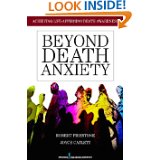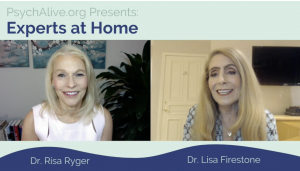Death Anxiety
 Although largely unconscious, the awareness of our finite existence, the fact that we all must die, has a profound impact on our thoughts, feelings, and behavior. The fear and emotional anguish associated with anticipating the end of life are so painful that we must protect ourselves. People find it difficult to tolerate facing their mortality directly, therefore, they repress the full realization of death and dying, and develop various defenses to keep the suppressed material at bay. As existential psychologists Victor Florian and Mario Mikulincer (2004) rightly observed, “The paralyzing terror produced by the awareness of one’s mortality leads to the denial of death awareness and the repression of death-related thoughts” (p. 61).
Although largely unconscious, the awareness of our finite existence, the fact that we all must die, has a profound impact on our thoughts, feelings, and behavior. The fear and emotional anguish associated with anticipating the end of life are so painful that we must protect ourselves. People find it difficult to tolerate facing their mortality directly, therefore, they repress the full realization of death and dying, and develop various defenses to keep the suppressed material at bay. As existential psychologists Victor Florian and Mario Mikulincer (2004) rightly observed, “The paralyzing terror produced by the awareness of one’s mortality leads to the denial of death awareness and the repression of death-related thoughts” (p. 61).
Most people would say they rarely think about death. Nevertheless, on an unconscious level, cognizance of our eventual demise arouses feelings of death anxiety that influence significant aspects of our lives and motivate many of our actions. Empirical studies by Terror Management Theory (TMT) researchers have demonstrated that people alter their behavioral responses and increase their reliance on specific defense mechanisms when their death salience is experimentally aroused.
In one experiment, after subjects were subliminally presented with the word “death,” they more strongly endorsed the worldview of their own ethnic group or nation while, at the same time, they denigrated members of other groups whose worldviews differed from their own. (Solomon, et al, 2015). In another, judges who were exposed to the word “death” administered more punitive sentences than judges in the control group who were not exposed. If the single word “death” introduced subliminally in an experimental setting can produce significant changes in subjects’ attitudes and actions, one can only imagine the powerful effect of countless events in the real world that remind people of their mortality.
The Child’s Awareness of Death
In general, the concept of death and the realization of a finite existence evolve gradually as a child matures. Young children, some as early as two years old, become aware of the fact of death—for example, when a pet dies or when they learn of the passing of a relative or close family friend. Between three and six years of age, children become conscious of the fact that their mother and father are vulnerable to death (Kastenbaum, 2000). Eventually, children realize that they, in fact, cannot sustain their own lives.
At this point, the world that they originally believed to be permanent is turned upside down. The dawning awareness and subsequent terror that they must die are intolerable and are necessarily repressed. Regardless of when this discovery occurs, it effectively destroys the child’s illusion of self-sufficiency. Even though defenses are instituted to block the awareness of death from consciousness, children’s fears are preserved in their entirety in the unconscious. Thereafter, the suppressed fear of death continues to exert a significant influence on the personal life of the developing child and, later, the adult.
Effects of Death Anxiety on the Individual
When their death anxiety is aroused, people tend to become increasingly defensive in ways that are harmful to themselves and often to others as well. Even though they may initially respond positively by embracing life more fully, over time, most people usually retreat to a more defended posture. As they deny death to protect themselves, they lose perspective, giving importance to insignificant issues in their lives while failing to value other relevant and meaningful influences. Many people tend to live life as though they will never die and can afford to squander their most valuable experiences.
Defensive reactions to death have a demoralizing effect on the individual. Tragically, many people end up losing their spirit and excitement toward life. They gradually become more rigid and controlling, thereby diminishing their range of experiences. They begin to entertain cynical or hateful attitudes toward self and others, give up interests that once excited them, and become progressively less joyful and more depressed and futile about life.
Most people embrace a religious dogma to maintain the hope or promise of an afterlife. In fact, belief in religion represents the most powerful denial of death. Some individuals over-intellectualize about the subject of death, taking a more philosophical position to keep themselves one step removed from feeling about their own mortality. Others find yet another solution: they believe that someone will ultimately save them—a relationship partner, a guru, or a political figure.
Some defenses against death anxiety have beneficial side effects; for example, the symbolic immortality that is fostered by the imagination of living on through creative works in art, literature, and science. Finding lasting meaning in devotion to family, friends, and people at large, and attempting to leave a positive legacy generally has a good effect. Other defenses, such as living on through one’s children, have a generally negative effect. Many children have suffered in their development from their parents’ efforts to make them into carbon copies of themselves.
Individual Defenses against Death Anxiety
Any negative event or reminder of death, such as illness, rejection, accident, or tragedy, can precipitate feelings of death anxiety, which in turn may lead to specific, idiosyncratic defenses. These defenses are not discrete entities, but are categorized here for the purpose of clarity.
Denial: Denying the reality of one’s finite existence is a major defense against death anxiety. It manifests in two forms: in the pursuit of literal immortality and symbolic immortality. Literal immortality is sought in religion or religiosity and is the key defense that negates the obvious scientific conclusion that human beings die like other species and that there is no proof of an afterlife. Monotheistic religious beliefs as well as some pantheistic or monistic spiritual traditions offer their followers a creation myth and version of life after death, which relieve the death anxiety that is caused by the unknowable. Symbolic immortality is sought in living on through one’s creative productions, one’s investment in causes, and one’s children. However, in the latter case, children are only able to relieve or buffer parents’ death anxiety if they adopt the cultural worldview or religious beliefs of their parents.
Vanity—Specialness and Magical Thinking: Vanity is an exaggerated positive view of the self that an individual uses to compensate for feelings of inadequacy and inferiority. It represents remnants of the child’s imagined invincibility, omnipotence, and invulnerability that live on in the psyche. It acts as a survival mechanism at times of stress or when people become painfully conscious of the fallibility of their physical nature and the impermanence of life. It expresses itself in the universal belief that death happens to someone else, never to oneself. The sense of specialness makes the person feel immune to the fate that awaits “ordinary” human beings.
The Accumulation of Power and Wealth: In business, politics, and organizational life in general, the drive to accumulate power and wealth is often motivated by a misguided belief that equates power and wealth with invincibility. People defend against death fears by attempting to gain control over others and by achieving financial success. Although conscious fears of death may be temporarily alleviated by these methods, the same fears still exist on an unconscious level and can actually increase in intensity as an individual amasses greater power.
Self-nurturing: Addictive behaviors and substance abuse support a person’s feeling of omnipotence and contribute to a pseudo-independent attitude of self-sufficiency. People use increasingly more sophisticated versions of self-nourishing habits to relieve emotional pain and existential anxiety. Indeed, the United States is currently suffering from a prescription drug and opioid problem of alarming proportions as individuals strive to obliterate the pain of their existence and numb themselves to the specter of death.
Preoccupation with Pseudo-problems: Most people seem intolerant of a simple, satisfying life and prefer to occupy their minds with melodrama and pseudo-problems while shutting off feeling for real issues in their lives. They often react dramatically to simple every day events with anger, fear, and panic. While preoccupied and suffering over these less meaningful concerns, they appear to be immune to death fears.
Addictive Couple Bonds: The destructive impact that defenses against death anxiety have on relationships by perpetuating the formation of self-limiting fantasy bonds has not been fully recognized. One of the things that invariably impresses me as a clinician is the extent to which people appear to want debilitating, conventional forms of safety, security, and “togetherness,” yet reject genuine closeness with their loved ones. Individuals tend to relive early childhood trauma in their present relationships and, at the same time, maintain a fantasy that they can somehow escape death by merging with another person.
Couples tend to act out reciprocal roles (dominant /submissive, parent/child etc.) in their interactions. Both participate in this damaging collusion and find it difficult to disengage because the polarized patterns provide an illusion of safety and wholeness and eventually contribute to a sense of immortality on an unconscious level. In coupling, they surrender their unique points of view, sense of self, and progressively limit their lives.
In describing how fantasies of fusion function to relieve death anxiety, TMT researchers Hart and Goldenberg (2008) asserted, “The modern era seems to have ushered in a spirituality of romantic love, an explicitly human-attachment-related solution to merge with others. Modern psychodynamic research shows that people can use romantic relations to protect themselves from the fear of death” (pp. 107-108).
Progressive Self-Denial and Micro-Suicide: A particularly insidious defense against death anxiety is one that I have termed micro-suicide: the commission of small “suicides” on a daily basis to achieve mastery over death. The universal tendency in “normal” individuals to be more or less self-destructive is not due to a death instinct; rather, it represents a formidable defense against the fear of death. By withdrawing feeling and positive energy from personal pursuits and goal-directed activity, individuals reduce their vulnerability to the anticipated loss of self through death. Ironically, by deadening themselves in advance, people barely notice the transition from living to dying.
Methods for Coping with Death Anxiety
Because there is no ultimate solution to the conundrum of death, when existential fears surface, people would ideally take time to face the reality of their mortality, identify and express the accompanying emotions of fear, sadness, and anger, and find a way to communicate their attitudes and thoughts with others. My associates and I suggest that talking about death anxiety with a friend or colleague while allowing a free flow of feelings can be especially helpful. Nevertheless, this may be difficult or largely unavailable because so many people are intolerant of the subject. Fortunately, it is possible to address the issue in psychology and philosophy courses, organized seminars and workshops, and in individual and group psychotherapy sessions.
As people expand their awareness of aloneness and existential issues of life and death, contemplate the essential dilemma and mystery of existence, and face their emotional pain, they generally develop a deeper and more abiding respect for other people’s feelings and well-being, as well as their own. These sentiments are translated into acts of kindness, sensitivity, and compassion toward other people who cross their path. When we challenge our defensive reactions to death anxiety, we are better able to confront death with equanimity, feel more aware, live in the present, and experience both the joy and pain of existence without resorting to fantasy and illusion. In becoming more open and vulnerable, we are able to more fully embrace love and the spirit of life.
Read Dr. Robert Firestone’s Article on Factors that Increase or Suppress Death Anxiety
Read Dr. Robert Firestone’s Article on Societal Defenses Against Death Anxiety
References
Florian, V., & Mikulincer, M. (2004). A multifaceted perspective on the existential meanings, manifestations, and consequences of the fear of personal death. In J. Greenberg, S. L. Koole, & T. Pyszczynski (Eds.), Handbook of experimental existential psychology (pp. 54—70). New York: Guilford.
Hart, J., & Goldenberg, J. L. (2008). A terror management perspective on spirituality and the problem of the body. In A. Tomer, G. T. Eliason, & P. T. P. Wong (Eds.), Existential and spiritual issues in death attitudes (pp. 91—113). New York: Lawrence Erlbaum.
Kastenbaum, R. (2000). The psychology of death (3rd ed.). New York: Springer.
Solomon, S., Greenberg, J., & Pyszczynski, T. A. (2015). The worm at the core: On the role of death in life. New York: Random House.









What does he believe about death? Is it THE END? Or is there something beyond for our souls once our physical bodies experience death?